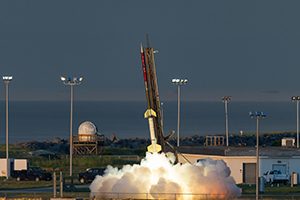UWM’s Students for the Exploration and Development of Space team participated in NASA’s Rocket Week at NASA’s Wallops Flight Facility in Virginia with the launch of a delicately engineered experiment into lower orbit.
Students nationwide participated in the RockSat-C program, which is a competitive project that engages students with the process of payload design, testing and launching. The payload is the experimental instrument aboard a rocket that collects and transmits data.
“NASA wants to put people on Mars. That means humans will be in space for extended periods of time,” said Dan Cairns, technical lead in UWM’s SEDS team. “What we need to understand is what exactly that cosmic radiation is going to do to humans in the long term.”

This is the third year UWM’s SEDS team has participated in the program. In previous years, the experiment has tested similar variables examining effects of radiation on genetic materials. This year, the team refined the design to operate more efficiently and effectively, remedying malfunctions and challenges faced in previous designs.
The project tests the effects of radiation on jellyfish DNA, which has similar reactive properties to radiation as seen in human DNA. Once the plasmids, or scraps of DNA, leave the protective atmosphere via rocket, they are exposed to radiation from space that may be damaging if not protected by the right materials.
In this year’s redesign, the project was improved by testing a wider variety of materials used to shield the DNA from radiation, according to Cairns.
Cairns worked late nights, early mornings and weekends alongside Kaitlin Krause, Daniel Gomez, Isaac Ngui and Wesley Roth. The team engineered components to withstand a high amount of pressure and temperature differentials when rocketing vials of DNA into space.
On June 20, their project, along with 27 others, was shot 73 miles into the sky via a sounding rocket, which is a rocket designed to perform and carry experiments. The rocket then returned to Earth, was retrieved by boat in the Atlantic, and data was collected for analysis.
“Within the next few weeks we’re hoping to see results that show there’s a clear correlation between cosmic radiation and DNA transfer effectiveness,” Cairns said. “Then we’ll be able to pass that data along to our NASA contact.”
The data will be used to improve the scientific understanding of biology and physics by determining the survivability of microorganisms in space flight.
“It’s going to be interesting to see if SEDS will be focused on things like another moon or Mars landing in future projects,” Cairns said.
In this new age of space exploration, potential research projects that might help NASA might include propulsion systems or rover missions, according to Cairns.
To learn more about the program and various experiments launched at this year’s Rocket Week, visit NASA’s Wallops Flight Facility.







